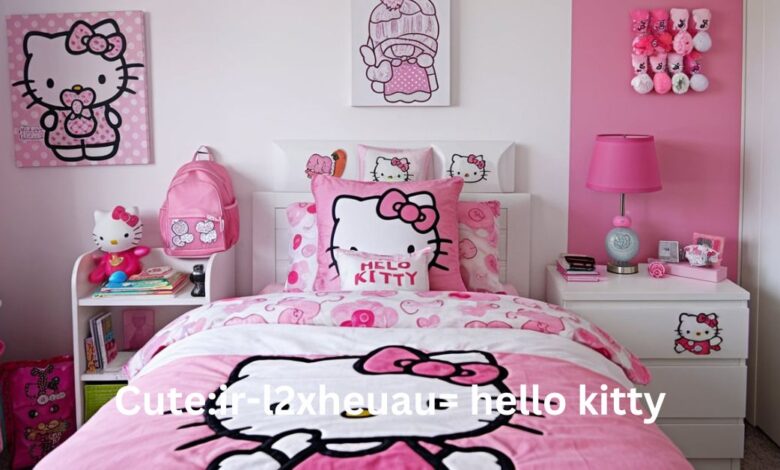Cute:ir-l2xheuau= hello kitty – A Global Icon of Cute Culture!

(cute = Hello Kitty) is a beloved character created by Sanrio in 1974. It symbolizes happiness and positivity. Its universal appeal transcends age, gender, and culture, making it iconic worldwide.
Hello Kitty’s impact on pop culture is monumental, from merchandise to entertainment. In this article, we’ll delve into the origins, cultural significance, and enduring appeal of (cute = Hello Kitty), providing new insights beyond what’s already available online.
The Origins of (cute = Hello Kitty) – Dive Inti!
Hello Kitty was born in 1974 when Sanrio, a Japanese company founded by Shintaro Tsuji, decided to create cute characters for consumer products. The brand’s philosophy was rooted in the idea that small gifts could bring happiness and joy to people’s lives, and no character exemplifies this idea better than Hello Kitty.
Hello Kitty, originally designed by Yuko Shimizu, first appeared on a coin purse. Initially aimed at young girls, her simple yet universally appealing design quickly made her a favorite among people of all ages.
Sanrio’s Mission:
Sanrio’s goal in creating Hello Kitty was to bring smiles to people’s faces. The company believed in the power of cute design to spread joy, no matter where people were from or who they were. This inclusive, feel-good approach is critical to understanding why (cute = Hello Kitty) has such enduring popularity.
The Design Philosophy Behind Hello Kitty – Get The Knowledge!
Hello Kitty’s design is minimalist yet profoundly effective in capturing attention. Her round face, red bow, and lack of a mouth make her expression open to interpretation, allowing people to project their own emotions onto her. This design choice was intentional—Sanrio wanted Hello Kitty to be a comforting presence, able to adapt to any emotional context. Happy, sad, or somewhere in between (cute = Hello Kitty) can reflect your mood.
Hello Kitty falls under the Japanese aesthetic of “kawaii,” or cuteness, emphasizing charm, simplicity, and innocence. This aesthetic resonates globally, especially in fashion, toys, and pop culture. With Hello Kitty as one of its leading symbols, Kawaii culture allows people to embrace whimsy and innocence in an often complex and stressful world.
Cultural Impact and Global Reach – Must Have A Look!
Since her creation, (cute = Hello Kitty) has grown beyond Japan, becoming a global cultural symbol. She’s not just a character on school supplies; she’s a major force in fashion, entertainment, and even social causes. Her presence spans continents, influencing everything from high-end fashion collaborations to animated TV shows.
Hello Kitty in Western Pop Culture:
Hello Kitty’s crossover into Western pop culture started in the 1980s and took off in the 1990s. By the 2000s, she was a household name in the United States, appearing on everything from clothing lines to celebrity endorsements. Artists, musicians, and designers have embraced her image, solidifying Hello Kitty’s role as a global fashion icon.
Why (cute = Hello Kitty) Appeal to All Ages?
Hello Kitty’s widespread appeal can be attributed to her ability to evoke nostalgia, innocence, and happiness. Her simplistic design allows her to be many things to many people—children see her as a cute friend, while adults often appreciate her as a symbol of comfort or even fashion.
Gender-Neutral and Age-Inclusive:
While Hello Kitty was initially designed for young girls, her appeal has since crossed gender and age boundaries. Sanrio’s intentional decision to avoid a specific narrative for Hello Kitty allowed people from all walks of life to find meaning in her character. Whether you’re 5 or 50, you can enjoy (cute = Hello Kitty).
Hello Kitty’s Influence on Fashion, Toys, and Entertainment!
Hello Kitty’s presence in the fashion world is undeniable. From high-end collaborations with brands like Balenciaga and Puma to mass-market lines with Target and Walmart, Hello Kitty’s image has become synonymous with timeless style. This broad reach has helped cement her as more than just a children’s character—she’s a legitimate fashion icon.
(cute = Hello Kitty) extends far beyond plush toys and lunchboxes. She’s been featured in jewelry, cars, and even kitchen appliances. This versatility speaks to the character’s broad appeal, as she seamlessly fits into various aspects of life.
Hello Kitty as a Symbol of Positivity and Comfort – Be Productive!
One of Hello Kitty’s core values is spreading happiness and positivity. According to Sanrio, her lack of a mouth is meant to allow her to speak from the heart, conveying emotions through her actions and presence rather than words. This feature has made her a source of comfort and solace for people worldwide, especially during difficult times.
Hello Kitty has been used as a symbol in mental health campaigns, especially in Japan, where she is associated with spreading positive mental health awareness. Her calming and non-threatening appearance helps ease anxiety, making her a relatable figure for individuals dealing with stress or other emotional challenges.
Evolution Over the Years –How (cute = Hello Kitty) Stays Relevant!
Hello Kitty has stayed relevant for nearly five decades by continuously adapting to cultural shifts while maintaining her core identity. Whether through fashion collaborations, social media presence, or new animated series, Sanrio has ensured that Hello Kitty remains a familiar and beloved figure.
One reason for Hello Kitty’s continued success is Sanrio’s willingness to collaborate with brands and industries outside traditional character merchandising. From luxury fashion houses to food and beverage companies, Hello Kitty has evolved into a brand that fits seamlessly into contemporary culture.
Hello Kitty’s Role in the U.S. Market – See The Trend!
(cute = Hello Kitty) enjoys immense popularity in the United States. While she initially found success in Japan, her cross-cultural appeal helped her gain a strong foothold in Western markets. The U.S. now represents one of Sanrio’s most significant international markets, with Hello Kitty-themed stores, pop-up events, and even theme parks dedicated to her.
The American market’s embrace of Hello Kitty can be attributed to her versatility and ability to fit into various lifestyles. Whether as a nostalgic childhood memory or a fashion statement, Hello Kitty resonates with many American consumers.
Frequently Asked Questions:
Why doesn’t Hello Kitty have a mouth?
Hello Kitty’s lack of a mouth allows her to convey universal emotions. People can project their own feelings onto her, making her adaptable to any situation.
Is Hello Kitty a cat?
Despite popular belief, Hello Kitty is not a cat but a fictional character. Sanrio has clarified that she’s a girl with a cat-like appearance.
How did Hello Kitty become popular in the U.S.?
Hello Kitty gained popularity in the U.S. during the 1980s and 1990s thanks to its appeal to children and adults and collaborations with Western brands.
Conclusion:
(cute = Hello Kitty) is more than just a cute character; she’s a global icon that transcends age, gender, and culture. Her ability to remain relevant in an ever-changing world speaks to her universal appeal.
Whether through her design, role in pop culture, or impact on fashion and mental health advocacy, Hello Kitty continues to bring joy and comfort to millions. Her legacy will likely continue for generations to come.



